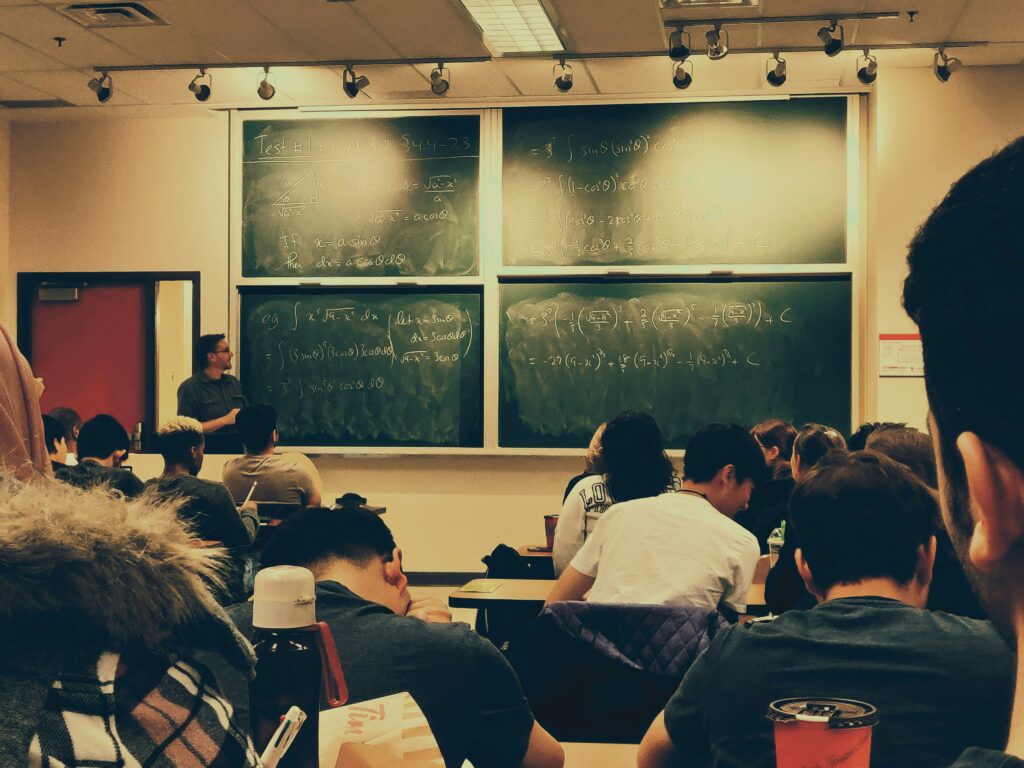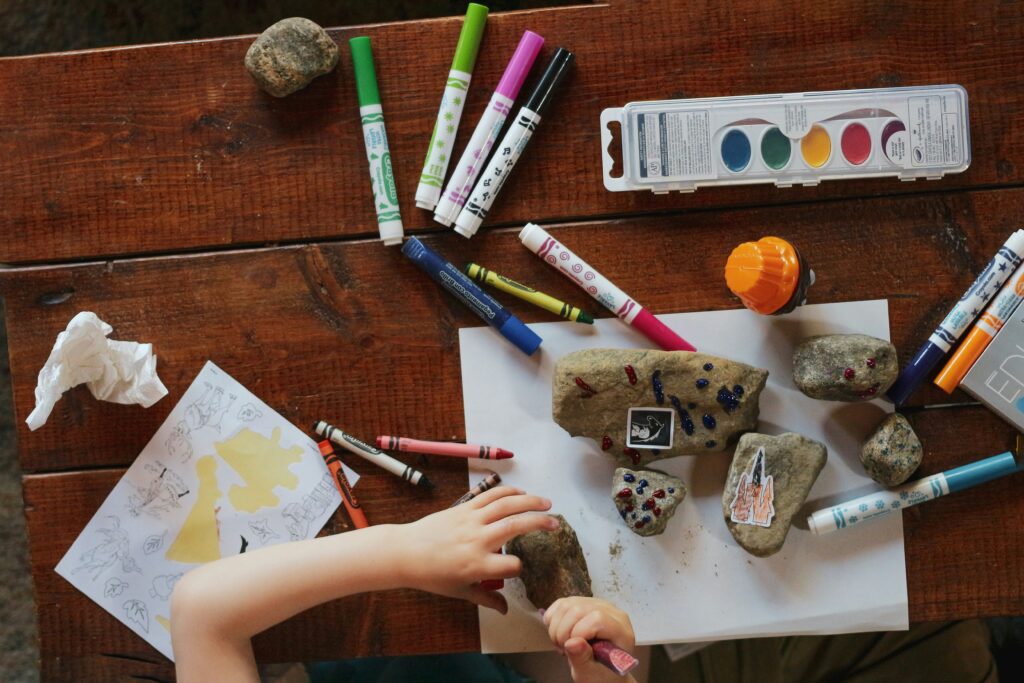Photo by Andrew Ebrahim on Unsplash
Backward Design and Understanding by Design

Backward design is a framework for planning lessons, modules, or entire courses. It starts with the learning objectives, which is what the student is expected to learn, and works backwards to create materials that facilitate their learning.
There are three main steps in backward design:
- Identify desired results.
- After completing a lesson, module, or course, what knowledge, skills, or abilities should students have achieved?
- Determine acceptable evidence.
- What will you include in your instruction to allow students to demonstrate their learning?
- e.g., assessments, projects, tests
- Plan learning activities and instructional materials.
- What activities and instruction will you provide to help students achieve the learning outcomes?
Planning instruction with learning outcomes in mind benefits both teachers and students. Teachers gain a clear set of goals, enabling them to design content, assessments, and activities that align with these goals. This ensures students have the resources to meet the intended outcomes. For students, it offers clarity on the course direction and the purpose of their learning.

I have noticed this approach throughout my university experience. In some classes, professors outline learning outcomes at the start of new topics or modules, explaining what we are expected to learn and why it matters. I did not understand the point of doing this at first, but upon reflection I find this very helpful, particularly when preparing for tests or working on projects. Referring to the learning outcomes can act as a checklist, where I can see if I am meeting all outcomes, identify gaps in my understanding, and target those areas for improvement.
Design Thinking and the Iceberg Model
Design thinking is a human-centred approach to problem-solving, helping us tackle challenges by creating innovative, relevant, and lasting solutions.
Design Thinking: A Problem-Solving Framework by, Edutopia
A particularly interesting concept in design thinking is the Iceberg Model. Often, problems persist because we focus only on visible symptoms, not underlying causes. The Iceberg Model helps us look beneath the surface to uncover patterns, structures, and mindsets that drive a system.
This deeper understanding is central to design thinking, which emphasizes empathy and fully exploring problems before jumping to solutions. By using the Iceberg Model, you can approach design thinking more effectively.
For example, if a school notices that students are underperforming, the initial assumption might be a lack of study time or effort. We can use The Iceberg Model to reveal deeper issues, such as disengaging teaching methods or a focus on memorization over critical thinking. With this in mind, design thinking allows educators to develop solutions that go beyond quick fixes, like designing lessons to be more interactive, incorporating project-based learning, or creating supportive feedback systems to address the root causes.

Personally, this framework has changed the way I think about problem-solving in learning. Through my volunteer work with children, sometimes i’ll notice that some of them seemed disinterested in the concepts we were discussing or the activities we planned. At first, I assumed this was simply a lack of interest in being there at all. Over time, I realized the barriers were often much deeper, sometimes the material felt confusing, or the activities didn’t connect to their real experiences. By experimenting with small changes and involving the kids in shaping the activities, I saw their engagement and understanding improve. This showed me how important empathy and prototyping can be in creating more meaningful learning experiences.
Learning Taxonomies
Learning taxonomies are research-based frameworks that serve as guidelines or conceptual maps for instructors. There are many learning taxonomies, including Bloom’s Taxonomy and the SOLO Taxonomy. Both are valuable tools for designing learning outcomes.
Personally, I find the SOLO Taxonomy easier to understand and more applicable to specific teaching outcomes. It emphasizes the quality and depth of the students understanding, rather than just one overall understanding. It explores the distinction between surface learning and deep learning which helps clarify these concepts and show how students’ understanding develops.
There are 5 levels to the SOLO Taxonomy:
- Prestructural: The student does not understand the concept yet.
- Unistructural: The student can identify the concept, make a relevant point, but overall can’t connect it to a bigger idea.
- Multistructural: The student understands the relevant information, but is not able to connect them together to form the big idea.
- Relational: The student can integrate several aspects into one understanding, and explain how the ideas relate.
- Extended Abstract: The student is able to go beyond the content to transfer the knowledge into different contexts and create original ideas.
When it comes to creating activities, learning outcomes, and assessments, it is important to keep these 5 levels in mind, as well as the surface level vs. deep learning.
| Surface Learning Tasks | Deep Learning Tasks |
| – Listing the parts of a plant | – Explain how parts of the plant work together to support growth |
| – Identify the planets in the solar system | – Explain the features of the different planets, and why we have life on earth |
| – Write down definition of “ecosystem” | – Create a plan for how a community could restore a damaged ecosystem |
Surface learning focuses on memorization and short-term performance, which may not ensure long-term retention or critical thinking. Deep learning encourages students to engage actively, think critically, and solve problems, enabling them to develop lasting understanding and transferable skills.

At university, I’ve taken classes focused mainly on facts and concepts, requiring memorization for success. In others, outcomes depend on how you engage with the material. Many psychology classes focus on specific concepts, making it challenging to incorporate deep learning. However, one professor I had encouraged deep learning by incorporating active engagement through discussions, activities, assignments with student-chosen topics, and open-ended exams. This required involvement with the content, resulting in deeper understanding and better retention compared to other classes I have had.
Inquiry and Project-Based Learning
Inquiry-based learning is a style that aims to use questions to encourage critical thinking and spark curiosity. Problem-based learning is a learning approach that is active, where students engage in collaboration and problem-solving to encourage critical thinking.
Inquiry-based learning and project-based learning are both beneficial to students’ learning, understanding, and skill-building. The context of the environment and course subjects is useful when determining which one to use.
Inquiry-Based Learning in the Science Classroom by Edutopia
In my learning journey, I’ve found both techniques very helpful, whether implemented in class or adopted independently for deeper self-study. In my future work with children, I plan to incorporate open-ended questions to foster critical thinking, creativity, confidence, self-expression, problem-solving, and communication. Though these methods can sometimes lead to students getting off-topic or require more time, the benefits far outweigh the drawbacks if implemented effectively.
Summary
Overall, a well thought out approach to lesson and course design with any of the techniques or taxonomies I have discussed in this blog post can benefit both the educators and students. For students, these practices can provide direction, motivation, and opportunities to develop transferable skills and a deeper understanding. I have definitely learned some valuable lessons that I will carry forward into my future.
References
DePaul University. (n.d.). Frameworks & taxonomies of learning. Teaching Commons, DePaul University. https://resources.depaul.edu/teaching-commons/teaching-guides/course-design/Pages/teaching-learning-frameworks.aspx
Distance Learning Institute. (2024, May 4). Deep vs. surface learning: Which approach wins? https://distancelearning.institute/instructional-design/deep-vs-surface-learning-approach/
McArdle, J. (2023, August 7). The power of open-ended questions for kids. My Teaching Cupboard. https://www.myteachingcupboard.com/blog/the-power-of-open-ended-questions-for-kids My Teaching Cupboard
Fastiggi, W. (2025, June 24). The SOLO Taxonomy Explained: A Practical Guide for Teachers. Technology for Learners. https://technologyforlearners.com/the-solo-taxonomy-explained-a-practical-guide-for-teachers/
University of Arkansas. (2022, June 26). Using Bloom’s Taxonomy to Write Effective Learning Objectives. https://tips.uark.edu/using-blooms-taxonomy/





I totally agree with you on the learning outcomes. They were a big help in my tough classes too, like math or computer science. At first, they felt unnecessary too, but now I see them as a roadmap. They show exactly what to focus on, making study time smarter. Like you said, they’re great checklists for tests and projects. You can tick off what you know, spot weak spots and fix them fast. In group work, they keep everyone on track and link ideas together and this builds confidence and deeper understanding. I think it’s like knowing the goal before playing the game. I also believe that professors should do this more as it makes learning active and not passive. For me, they greatly helped me in my data structures class where I was totally clueless about what to expect and what competencies were going to come out of it. When the course was over, I took a look at the learning outcomes, and I could see a lot of what I learnt really resonated with the learning outcomes that I saw at the beginning.
I really enjoyed reading your post—your explanations of backward design and the Iceberg Model were especially clear and engaging. I liked how you connected design thinking to your volunteer experience with children; it made the theory feel personal and practical. Your discussion of the SOLO taxonomy also stood out—it was concise but showed a strong understanding of how deep learning develops over time, and the comparison table between surface and deep learning tasks made the concept easy to grasp.
I worry that the post focuses mainly on describing the frameworks, and I wonder if you could expand a bit more on how educators might practically integrate these models together in a single lesson or course. For instance, how might design thinking and backward design complement each other in creating deeper learning outcomes?
Your blog layout looks clean and inviting, with visuals that break up the text nicely. I wonder if adding short subhead summaries or a brief reflection section after each framework might make it even easier for readers to follow your key takeaways.